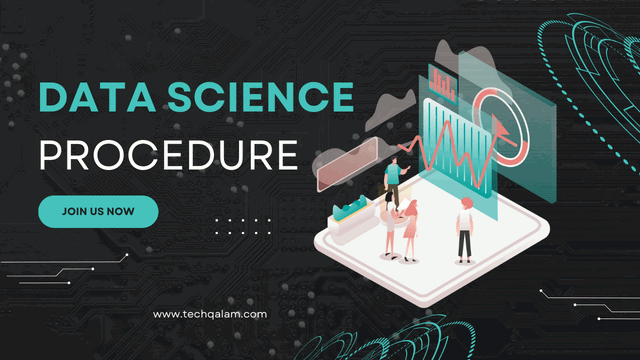Data Science: The Ultimate Guideline
Preface
Data Science: The ultimate guideline for Businesses is increased reliance on data science to improve customer satisfaction and expand operations due to the huge amount of data generated today.

♦ What is your understanding of data-science?
Data-Science: The ultimate guideline for Combining computer science, machine literacy, statistics, and mathematics is called data science.
The process of gathering, assessing, and interpreting data in order to draw conclusions from it that will enable decision-makers to act with confidence is known as data science.
Moment, data-science is employed in virtually every endeavor to read consumer gets, spot arising trends, and spot business possibilities.
It can support companies in making knowledgeable decisions about product development and marketing. It’s a tool for fraud detection and process optimization.
The government also employs data intelligence to improve the efficiency with which public services are delivered.
“Simply put, data-science is the operation of statistics, mathematics, programming, and subject matter moxie to dissect data and determine meaningful perceptivity from it”.
♦ Importance of Data Science
Nowadays, Data-science—the ultimate guideline for organizations—is overwhelmed with data. Data science, through fusing different techniques, technologies, and tools, will assist in deriving useful insights from it.
Businesses deal with massive volumes of data in e-commerce, banking, healthcare, human resources, and other areas. Data Science is The ultimate guideline, and Data Science tools and technologies help them process all of them.
♦ Background of Data-Science
Ahead of schedule during the 1960s, the expression “data science” was introduced to help understand and investigate the huge volumes of information being assembled at that point.
Data-science, the ultimate guideline, is an ever-evolving field that uses quantifiable methods and software engineering to extract insights and generate critical predictions for a range of industries.
Data science is an ever-evolving field that uses quantifiable methods and software engineering to extract insights and generate critical predictions for a range of industries.
♦ Data Science Prerequisites
¤ Statistics in Data Science
In order to efficiently identify and work with data patterns and turn them into relevant evidence, data scientists mostly rely on statistical techniques. The use of advanced machine-learning algorithms facilitates this process.
¤ Programming Languages in Data-Science
SQL, R, and Python are most famous programming languages in this field.
To effectively execute a data science project, imparting some degree of programming knowledge is significant.
¤ Machine Learning in Data Science
Machine learning, a main element of data-science, enables the creation of precise forecasts and evaluations. If you wish to succeed in the field of data science,
¤ Databases in Data Science
Expertise in database management and data extraction is most important for success in the field of data science.
¤ Making Models in Data-Science
With numerical models, you can quickly determine and predict based on the data that you are certain about. Displaying aids in determining how to create these models and which computation is best suited to address a certain problem.
♦ Who is in charge of the data-science function?
¤ Business Managers
Data Science: The ultimate guideline for the individuals in charge of managing the data science training approach are business managers. Their primary responsibility is to characterize the issue and offer an analytical solution in collaboration with the data science team.
An executive in charge of the department may appoint a data scientist to supervise the marketing, finance, or sales departments. To ensure that projects are completed on schedule, they collaborate closely with data scientists and IT managers.
¤ Information Technology Managers
Data science—the ultimate guideline for IT managers—comes next. The duties will surely be more significant than any others if the member has been with the organization for a long period.
Building the infrastructure and architecture required to support data science initiatives is their primary responsibility.
To guarantee that data-science teams work effectively and safely, they are continuously observed and assigned the appropriate resources.
¤ Data Science Managers
The last group is made up of data science managers. Their main responsibility is to monitor and track each member of the data science team’s workflow.
♦ Data-science Purpose
¤ Analyzing Descriptively
It aids in precisely showing data points for potential patterns that meet all criteria for the data. Otherwise, it entails arranging, arranging, and modifying data in order to generate knowledge that is perceptive about the data that is provided.
It also entails transforming unprocessed data into a format that is easy to understand and analyze.
¤ Preliminary Examination
It is the process of predicting future outcomes by combining historical data with different approaches such as statistical modeling, data mining, and machine learning. Businesses utilize predictive analytics to identify risks and opportunities by using trends found in this data.
¤ Diagnostic Examination
It takes a thorough investigation to figure out why something occurred. It is described by methods such as correlations, data mining, drill-down, and data discovery.
On a given data set, various data operations and transformations can be carried out to find distinct patterns in each of these methods.
¤ Prescriptive Evaluation
Data-Science: The ultimate guideline for the application of predictive data is advanced by prescriptive analysis. It predicts what is most likely to happen and suggests the best way to handle that outcome.
It can determine the best course of action and evaluate the likely consequences of different choices. It uses neural networks, complex event processing, machine learning recommendation engines, simulation, graph analysis, and neural networks.

♦ What steps make up the data-science procedure?
¤ Collecting the Data
The first step is to figure out what kind of data has to be examined, then export that information to a spreadsheet program like Excel or a common data-storage format like CSV.
¤ Cleaning the information
It’s crucial because you can’t possibly interpret the information unless all the pieces are in place and the information is in the correct format.
¤ Exploratory Study
Data analysis is looking for out-of-the-ordinary trends or patterns by exploring the data in a number of different visual representations. A keen eye for detail is required to examine the data and spot any discrepancies.
♦ Methods of Machine Learning and Modeling
Data Science: The ultimate guideline to guide the Machine Learning algorithm in its analysis is that a data engineer or scientist documents the necessary steps. The algorithm loops through these parameters to produce the desired result.
¤ Making sense of the numbers
This is where you reveal your findings and share them with the company. The ability to explain outcomes would be the most important skill here.
¤ Data-Science Tools
These are some illustrations of tools that can help data scientists have an easier time doing their jobs.
¤ Data Analysis
Informatica Power Center, Rapidminer, Excel, and SAS for data analysis
¤ Data Visualization
RAW, Jupyter, Tableau, and Qlikview
¤ Data Warehousing
Microsoft HD Insights, Informatica/Talend, and Apache Hadoop
¤ Data Modelling
Azure ML Studio, Mahout, Datarobot, H2O.ai, and data modeling

♦ Data Mining Benefits in Business
- Enhances business forecasts;
- Facilitates the interpretation of complex data;
- Enhances decision-making; fosters product innovation;
- Fortifies data security;
- And produces user-focused goods
♦ Data Science Application
· Medical
· Transport
· Finance
· E-commerce
· Health care
· Image Recognition
· Airline routing Planning
· Gaming
· Delivery logistics
· Autocomplete
♦ What are different data-science technologies?
Data Analytics: The ultimate guideline for professionals in the field of data science is to use sophisticated tools like:
¤ Artificial Intelligence
For predictive and prescriptive analysis, AI first employs machine learning models and associated tools.
¤ Cloud computing
Data scientists now have the freedom and computational capacity necessary for complex data analytics, thanks to cloud computing.
¤ Internet of Things
IoT, or the Internet of Things, is a term used to describe a wide range of connected objects that may connect to the web on their own.
These gadgets are used to gather information for data science projects. They produce reams of information useful for data extraction and mining.
¤ Quantum computing
Quantum computing, number four: it can quickly and accurately complete complex calculations. They are used by competent data scientists in the construction of intricate quantitative algorithms.

♦ Why become an analyst of data?
Data scientists have been among the top three careers in America, according to Glassdoor, since 2016. Big IT companies aren’t the only ones in need of data scientists as access to larger and more accessible data sets grows.
The insufficient pool of skilled applicants to fill existing roles is posing a barrier to the expanding need for data science specialists in all sectors of the economy, regardless of size.
In the upcoming years, there is no indication that the demand for data scientists will decrease. Multiple data-science-related talents are the most in-demand by firms, and LinkedIn identified data scientists as one of the most promising occupations.
FAQs about Data Science: The ultimate guideline
1. What is the work of a data scientist?
To examine data, data scientists develop and apply algorithms. Typically, this process entails utilizing and developing individualized data products and machine learning techniques to assist clients and enterprises in effectively interpreting data.
2. Are math and data-science related?
A key component of data-science is math. It can support problem-solving, model performance optimization, and the interpretation of complex data to address business-related queries.
3. Data science: is it simple?
Yes, getting into a data-science degree might be challenging because it requires a strong foundation in math, statistics, and computer programming abilities.
But anyone who puts in the necessary time and effort can learn the skills and information needed to succeed in this field.
4. Does coding come with data-science?
Coding expertise has always been required for data science positions, and the majority of seasoned data scientists in employment today still code.
But the field of data-science is still evolving, and there are now tools available that let users finish full data projects without writing any code.
5. Is AI easier than data science?
Deep learning and machine learning are used in data-science to interpret data. In general, data science is easier to understand than artificial intelligence (AI), as the former focuses on creating robots that can perform tasks that people can, while the latter uses math and statistics to analyze data.
Conclusion
In this edition, “Data Science: The ultimate Guideline,” The development of a company benefits greatly from the utilization of data science tools and methods.
Every industry is undergoing a digital change, and as a result, organizations are offering attractive pay to attract qualified employees who possess the necessary skills and knowledge.
Careers in data-science, or transitioning to them from other fields like business analysis, data analysis, data engineering, analytics engineering, etc.
Unlock all prompts: https://bitly.com/science







